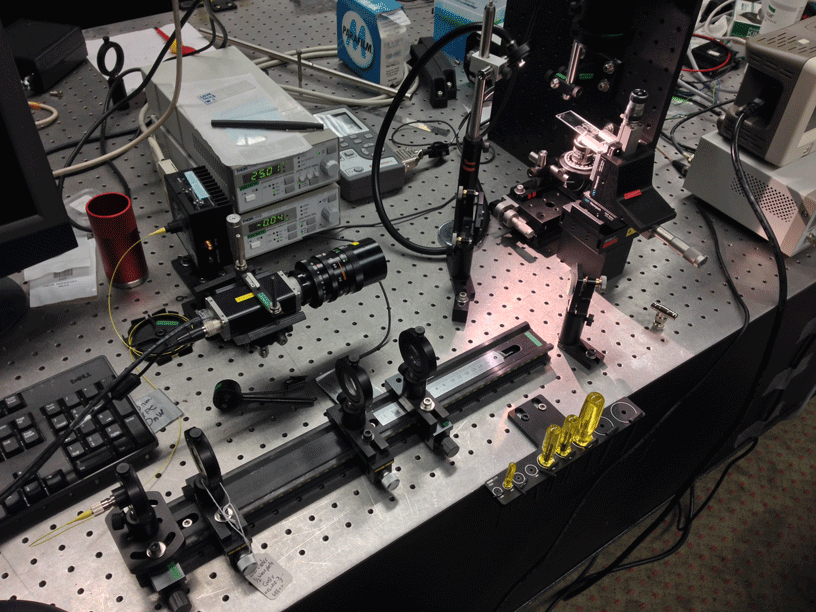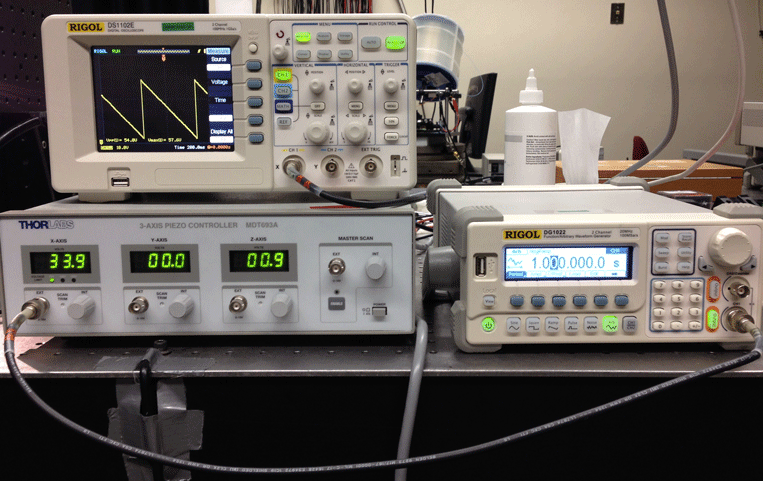Stokes' Drag Force and Trap Forces¶
Measuring trap forces using stokes' drag force
Brian Perrett, Samuel Estrella, Kyle Eichenberger
5/28/14
Advanced Optics Lab 491
University of Oregon
Fd=6πμRvs
μ is the dynamic viscosity (8.90∗10−4Pa∗s)
R is the radius of the sphere
vs is the particle's velocity
We slowly accelerate the particle on a translational stage until the sphere breaks from the trap. We measure the velocity at which the sphere breaks from the trap to calculate our drag force, and equate it to the trap stiffness
Fd=k
where k is our trap force
Devices and Setup


RESULTS¶
| Beam Power (mW) | Escape Velocity (microns/second) | Trap Force (pN) |
|---|---|---|
| 5.5 | 20.57 | 0.44 |
| 8.5 | 33.49 | 0.72 |
| 11.7 | 40.00 | 0.86 |
| 15.3 | 62.60 | 1.34 |
| 19.0 | 84.71 | 1.82 |
| 23.0 | 110.77 | 2.38 |
plot(beam_strengths, trap_strengths, 'bo', label='Trap Force')
plot(line, fit, 'r-', label='Best Fit Trap Force vs Beam Strength')
title('Trap Force vs Beam Strength')
xlabel('Beam Power (mW)')
ylabel('Trap Force (pN)')
legend()
print("Slope is " + str(p[0]))
Slope is 0.110650667695
Calculations¶
mu = 8.9e-4 #Pa*S
R = 2.56e-6/2 #meters
5.5mW Beam Strength
- T = 0.7 seconds
- Vpp = 54V
T = .7 #seconds
V = 54 #Volts
dist = (20e-6*54)/75
v_s = dist/T
print("v_s is " + str(v_s))
F_d = 6*pi*mu*R*v_s
print("F_d is " + str(F_d))
k1 = F_d
v_s is 2.0571428571428573e-05 F_d is 4.417388044625202e-13
8.5mW Beam Strength
- T = 0.43 seconds
- Vpp = 54V
T = .43 #seconds
V = 54 #Volts
dist = (20e-6*54)/75
v_s = dist/T
print("v_s is " + str(v_s))
F_d = 6*pi*mu*R*v_s
print("F_d is " + str(F_d))
k2 = F_d
v_s is 3.348837209302325e-05 F_d is 7.191096816831723e-13
11.7mW Beam Strength
- T = 0.36 seconds
- Vpp = 54V
T = .36 #seconds
V = 54 #Volts
dist = (20e-6*54)/75
v_s = dist/T
print("v_s is " + str(v_s))
F_d = 6*pi*mu*R*v_s
print("F_d is " + str(F_d))
k3 = F_d
v_s is 3.9999999999999996e-05 F_d is 8.58936564232678e-13
15.3mW Beam Strength
- T = 0.23 seconds
- Vpp = 54V
T = .23 #seconds
V = 54 #Volts
dist = (20e-6*54)/75
v_s = dist/T
print("v_s is " + str(v_s))
F_d = 6*pi*mu*R*v_s
print("F_d is " + str(F_d))
k4 = F_d
v_s is 6.260869565217391e-05 F_d is 1.3444224483641918e-12
19.0mW Beam Strength
- T = 0.17 seconds
- Vpp = 54V
T = .17 #seconds
V = 54 #Volts
dist = (20e-6*54)/75
v_s = dist/T
print("v_s is " + str(v_s))
F_d = 6*pi*mu*R*v_s
print("F_d is " + str(F_d))
k5 = F_d
v_s is 8.470588235294117e-05 F_d is 1.8189244889633183e-12
23.0mW Beam Strength
- T = 0.13 seconds
- Vpp = 54V
T = .13 #seconds
V = 54 #Volts
dist = (20e-6*54)/75
v_s = dist/T
print("v_s is " + str(v_s))
F_d = 6*pi*mu*R*v_s
print("F_d is " + str(F_d))
k6 = F_d
v_s is 0.00011076923076923076 F_d is 2.378593562490493e-12
beam_strengths = [5.5, 8.5, 11.7, 15.3, 19.0, 23.0] #mW
trap_strengths = array([k1, k2, k3, k4, k5, k6]) #N
trap_strengths = trap_strengths*1e12 #convert to pN
plot(beam_strengths,trap_strengths, 'bo')
p = polyfit(beam_strengths, trap_strengths, 1)
line = linspace(5,30,2)
fit = p[1] + p[0]*line
plot(line, fit, 'r-')
[<matplotlib.lines.Line2D at 0x8d2b198>]
These calculations turned out better than I had imagined they would. There is bit of uncertainty in deciding exactly when the spheres escape the optical trap, but it worked out quite well here.
Using this data, we can extrapolate what our Trap Force would be at the maximum intensity of 67.8mW.
p[1] + p[0]*67.8
7.2317352916171069
We would expect a trap force of 7.23pN at an intensity of 67.8mW